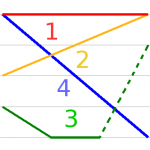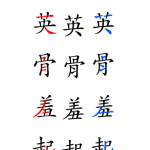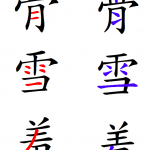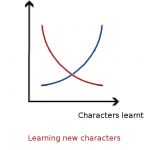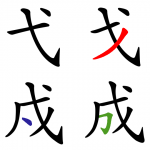Articles in the ‘Vocabulary’ category Page 10
-
Learning tones in Mandarin is not optional
Learning tones in Mandarin is not optional. The longer you wait before paying attention to tones, the more you will have to relearn later. If you don’t know the tone, you don’t know the word. It takes time to learn to hear tones and treat them as integral parts of syllables, but the sooner you start, the better.
Read → -
How to verify that you use the right Chinese font
For second language learners, using the wrong font can make learning characters very confusing. In this article, I will help you verify that you have the right fonts installed and discuss what happens if you don’t. This is a follow-up to an earlier article about Chinese fonts for students.
Read → -
Chinese character variants and fonts for language learners
Chinese character variants and regional font standards can be really confusing for language learners. As if simplified/traditional wasn’t enough, characters can look different depending on the font used or where the text was printed! This article will help you understand what’s going on.
Read → -
The real challenge with learning Chinese characters
The real challenge when learning Chinese characters is not to commit a large number of them to memory, it’s to relate them to each other, including how they are used, how they are different and how they are similar. Creating such an interconnected web is a lifelong project.
Read → -
Which words you should learn and where to find them
When learning a language, it’s important to know many words, but it’s also important that you learn the right words. How do you know which words to learn? Where should you find those words? And how much can you express using the ten hundred most common words?
Read → -
Learning Chinese characters through pictures
This article is about using pictures to learn Chinese characters. In order to learn characters efficiently, it’s important to understand how they work and what the building blocks are so that these can be used in other characters. Any pictures you use to remember should be based on this. Avoid using pictures that obscure the real meaning.
Read → -
Panning: How to keep similar Chinese characters and words separate
The real challenge when learning Chinese characters and words isn’t to remember them, it’s to keep them separate from each other. This article concludes my series about zooming and panning to integrate your knowledge better.
Read → -
Zooming out: The resources you need to put Chinese in context
In order to learn efficiently, it’s important that you integrate your knowledge. This means being able to break down Chinese in order to understand it, as well as looking at context and sorting out confusing cases. In this second article, I introduce tools for zooming out and putting things in context.
Read → -
Zooming in: The tools you need to break down and understand Chinese
In order to learn efficiently, it’s important that you integrate your knowledge. This means being able to break down Chinese in order to understand it, but it also means looking at context and sorting out confusing cases. In this first article, I introduce tools for breaking Chinese down.
Read → -
The best Twitter feeds for learning Chinese in 2015
Who should you follow on Twitter if you want to learn Chinese? There’s an increasing number of people who tweet excellent language content within the 140 character limit, often with pictures. This article contains a list of the 9 best ones, including a short intro and examples of what they tweet.
Read →
